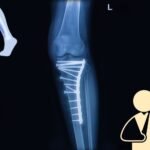A fracture is a break or crack in a bone, and it can occur in various parts of the body due to different causes. While bones are generally strong, they can break when subjected to extreme forces such as sudden impacts, falls, or direct blows. Fractures vary in severity and can range from minor cracks to complete breaks that penetrate the skin.
Common Causes of Fractures
- Trauma: Sudden impacts from falls, accidents, or contact sports can cause fractures. Car accidents and high-contact sports like football, rugby, or hockey are frequent causes.
- Overuse: Repetitive stress over time, especially in athletes and those with physically demanding jobs, can lead to stress fractures, which are small cracks in the bone.
- Osteoporosis: This condition weakens bones, making them more susceptible to fractures. Older adults are at higher risk due to reduced bone density.
- Medical Conditions: Certain diseases, such as bone cancer or conditions that affect bone strength, can make bones more vulnerable to fractures even with minimal trauma.
Types of Fractures
- Simple (Closed) Fracture: The bone is broken, but the skin remains intact. These fractures are less severe and carry a lower risk of infection.
- Compound (Open) Fracture: The bone breaks through the skin, exposing the fracture to the environment. This type of fracture requires immediate medical attention to prevent infection.
- Comminuted Fracture: The bone shatters into multiple pieces. This is usually caused by high-energy trauma and may require surgery to repair.
- Greenstick Fracture: Common in children, this occurs when the bone bends and cracks but doesn’t break completely.
- Transverse Fracture: A straight break across the bone, usually caused by a direct impact.
- Oblique Fracture: The break occurs at an angle, often caused by twisting injuries.
- Stress Fracture: A hairline crack in the bone caused by repetitive strain, commonly seen in runners or athletes.
- Spiral Fracture: Caused by a twisting motion, this fracture spirals around the bone and often occurs in sports or accidents.
Symptoms of a Fracture
- Intense Pain: A sharp, localized pain occurs at the site of the fracture, especially when moving the affected area.
- Swelling and Bruising: Swelling around the fractured area is common, accompanied by bruising.
- Deformity: In some cases, the limb or bone may appear deformed or out of alignment.
- Loss of Function: Difficulty or inability to move the affected area is a clear sign of a fracture.
- Tenderness: The area around the fracture is usually tender to the touch.
Diagnosis
To diagnose a fracture, medical professionals typically perform:
- X-rays: The most common method to identify the location and extent of the fracture.
- CT Scans or MRIs: In more complex cases, these imaging techniques are used to get a more detailed view of the fracture, especially for fractures in joints or multiple injuries.
Treatment of Fractures
The treatment of a fracture depends on its severity and type but typically involves the following:
- Immobilization: For most fractures, immobilizing the affected area using a cast, splint, or brace allows the bone to heal naturally. This can take several weeks to months, depending on the location and severity of the fracture.
- Surgery: In severe cases, such as compound or comminuted fractures, surgery may be required to realign the bones. Metal plates, screws, or rods are often used to stabilize the fracture while it heals.
- Pain Management: Over-the-counter pain relievers or stronger prescription medications may be used to manage pain during the healing process.
- Physical Therapy: Once the bone starts healing, physical therapy is crucial to regain strength, flexibility, and range of motion in the affected area.
Recovery Process
Fractures usually take anywhere from a few weeks to several months to heal, depending on the type and location. Factors that affect the recovery time include:
- Age: Younger individuals tend to heal faster than older adults.
- Bone Density: Those with conditions like osteoporosis may experience slower healing.
- Location: Bones in areas like the leg or arm may take longer to heal due to the constant use of these limbs.
Proper rest, nutrition, and following medical advice are essential for a full recovery.
Prevention of Fractures
While not all fractures can be prevented, taking certain precautions can reduce the risk:
- Wear Protective Gear: Helmets, pads, and other protective equipment can prevent fractures during sports or physical activities.
- Strength Training: Building muscle around bones can help protect them from fractures.
- Bone Health: Maintaining a healthy diet rich in calcium and vitamin D can strengthen bones and reduce the risk of fractures.
- Avoid Overuse: For athletes, incorporating rest days and cross-training can prevent stress fractures caused by repetitive strain.
Conclusion
Fractures can disrupt daily life and lead to significant discomfort, but with proper care and timely treatment, most people make a full recovery. Understanding the causes, types, and prevention strategies helps in minimizing the risk of fractures and promotes long-term bone health.













